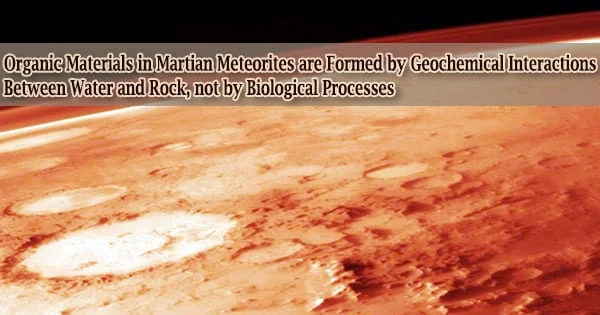According to a new study conducted by Carnegie’s Andrew Steele and published in Science, organic compounds identified in a meteorite that crashed to Earth from Mars were created via interactions between water and rocks on the Red Planet some 4 billion years ago.
The meteorite, known as Allan Hills (ALH) 84001, was discovered in the Antarctic in 1984 and is one of the earliest known projectiles from Mars to reach Earth.
“Analyzing the origin of the meteorite’s minerals can serve as a window to reveal both the geochemical processes occurring early in Earth’s history and Mars’ potential for habitability,” explained Steele, who has done extensive research on organic material in Martian meteorites and is a member of both the Perseverance and Curiosity rovers’ science teams.
Organic molecules are made up of carbon and hydrogen, with oxygen, nitrogen, sulfur, and other elements are thrown in for good measure. Organic chemicals are typically linked with life, although they can also be produced by non-biological processes, known as abiotic organic chemistry.
For years, scientists have debated the origin story for the organic carbon found in the Allan Hills 84001 meteorite, with theories ranging from abiotic processes such as volcanic activity, impact events on Mars, or hydrological exposure to ancient life forms on Mars or contamination from the meteorite’s crash landing on Earth.
Analyzing the origin of the meteorite’s minerals can serve as a window to reveal both the geochemical processes occurring early in Earth’s history and Mars’ potential for habitability.
Andrew Steele
The Steele-led team, which also included Carnegie’s Larry Nittler, Jianhua Wang, Pamela Conrad, Suzy Vitale, and Vincent Riggi as well as researchers from GFZ German Research Center for Geosciences, Free University of Berlin, NASA Johnson Space Center, NASA Ames Research Center, and Rensselaer Polytechnic Institute, used a variety of sophisticated sample preparation and analysis techniques including co-located nanoscale imaging, isotopic analysis, and spectroscopy to reveal the origin of organic molecules in the Allan Hills 84001 meteorite.
They discovered indications of water-rock interactions that are similar to those occurring on Earth. According to the samples, the Martian rocks underwent two major geochemical processes.
One, known as serpentinization, occurs when iron- or magnesium-rich igneous rocks interact chemically with circulating water, altering their mineralogy and creating hydrogen.
Carbonization, on the other hand, occurs when rocks mix with slightly acidic water containing dissolved carbon dioxide, resulting in the creation of carbonate minerals.
It’s unclear if these activities were triggered concurrently or sequentially by the surrounding aquatic conditions, but the data suggest that the interactions between water and rocks did not last long. However, it is clear that the reactions resulted in the formation of organic material as a result of the reduction of carbon dioxide.
Carbonation and serpentinization have been seen in orbital surveys of Mars, and carbonation has been identified in other, less-old Martian meteorites, but this is the first time these processes have been found in samples from ancient Mars.
Steele has found organic compounds in additional Martian meteorites and in his work with the Curiosity rover’s Sample Analysis at Mars (SAM) team, demonstrating that abiotic synthesis of organic molecules has been a feature of Martian geochemistry for a long time.
“These kinds of non-biological, geological reactions are responsible for a pool of organic carbon compounds from which life could have evolved and represent a background signal that must be taken into consideration when searching for evidence of past life on Mars,” Steele concluded.
Furthermore, if similar processes occurred on ancient Mars, they must have also occurred on ancient Earth, which could explain the findings from Saturn’s moon Enceladus. For this sort of organic synthesis, all that is required is for a brine containing dissolved carbon dioxide to seep through igneous rocks.
“The search for life on Mars is not just an attempt to answer the question ‘are we alone?’ It also relates to early Earth environments and addresses the question of where did we come from?”
The US Antarctic meteorite samples were recovered by the Antarctic Search for Meteorites (ANSMET) program, which has been funded by NSF and NASA and characterized and curated by the Department of Mineral Sciences of the Smithsonian Institution and the Astromaterials Acquisition and Curation Office at NASA Johnson Space Center, respectively.
NASA, Carnegie’s Earth and Planets Laboratory, and the Helmholtz Recruiting Initiative program all contributed to this research.





